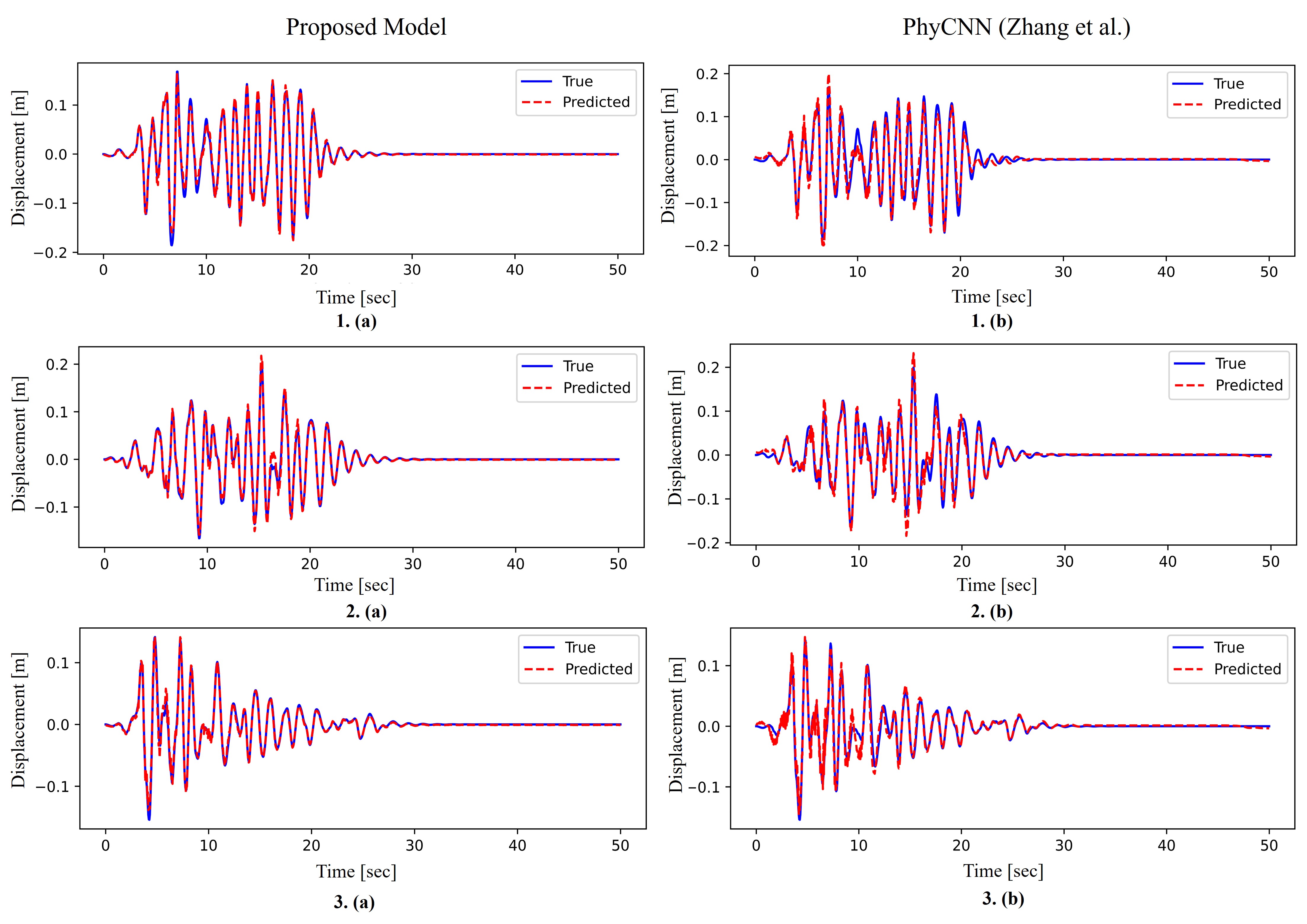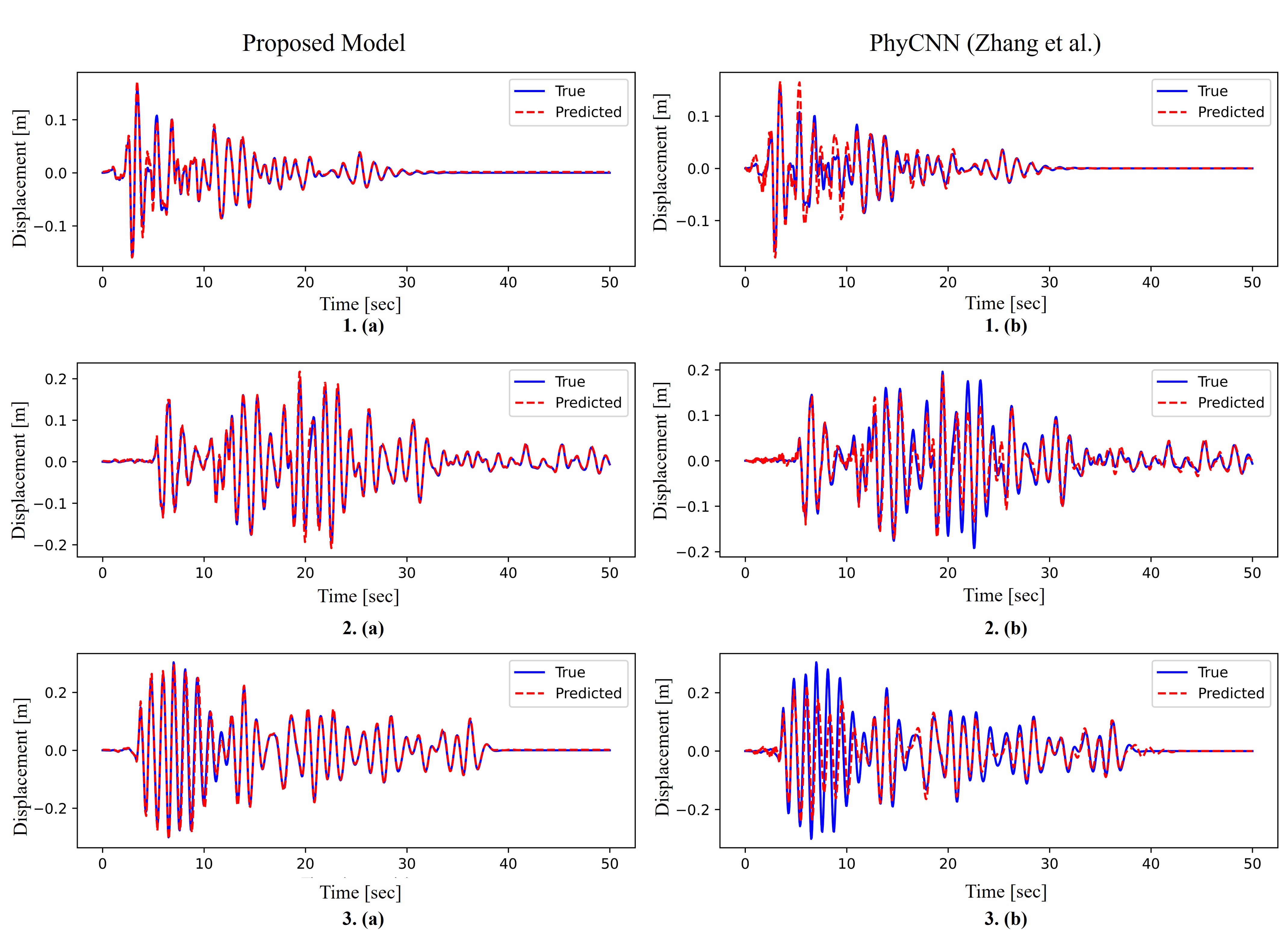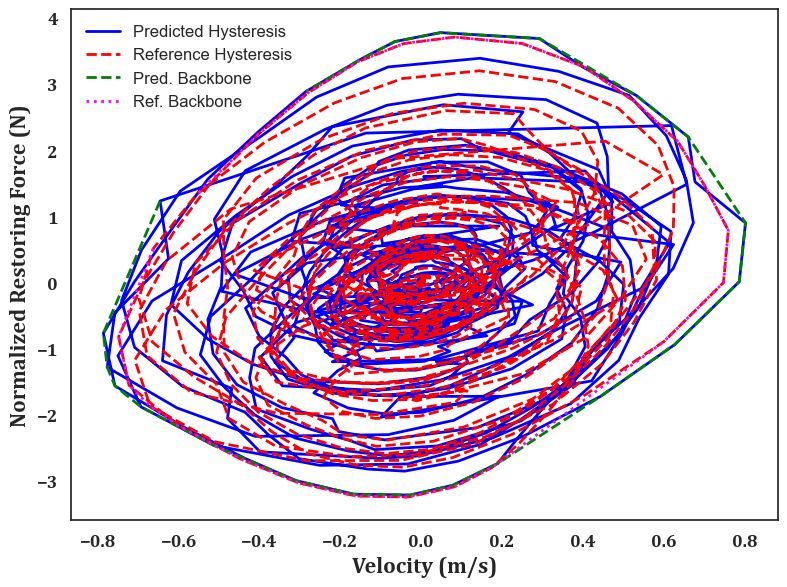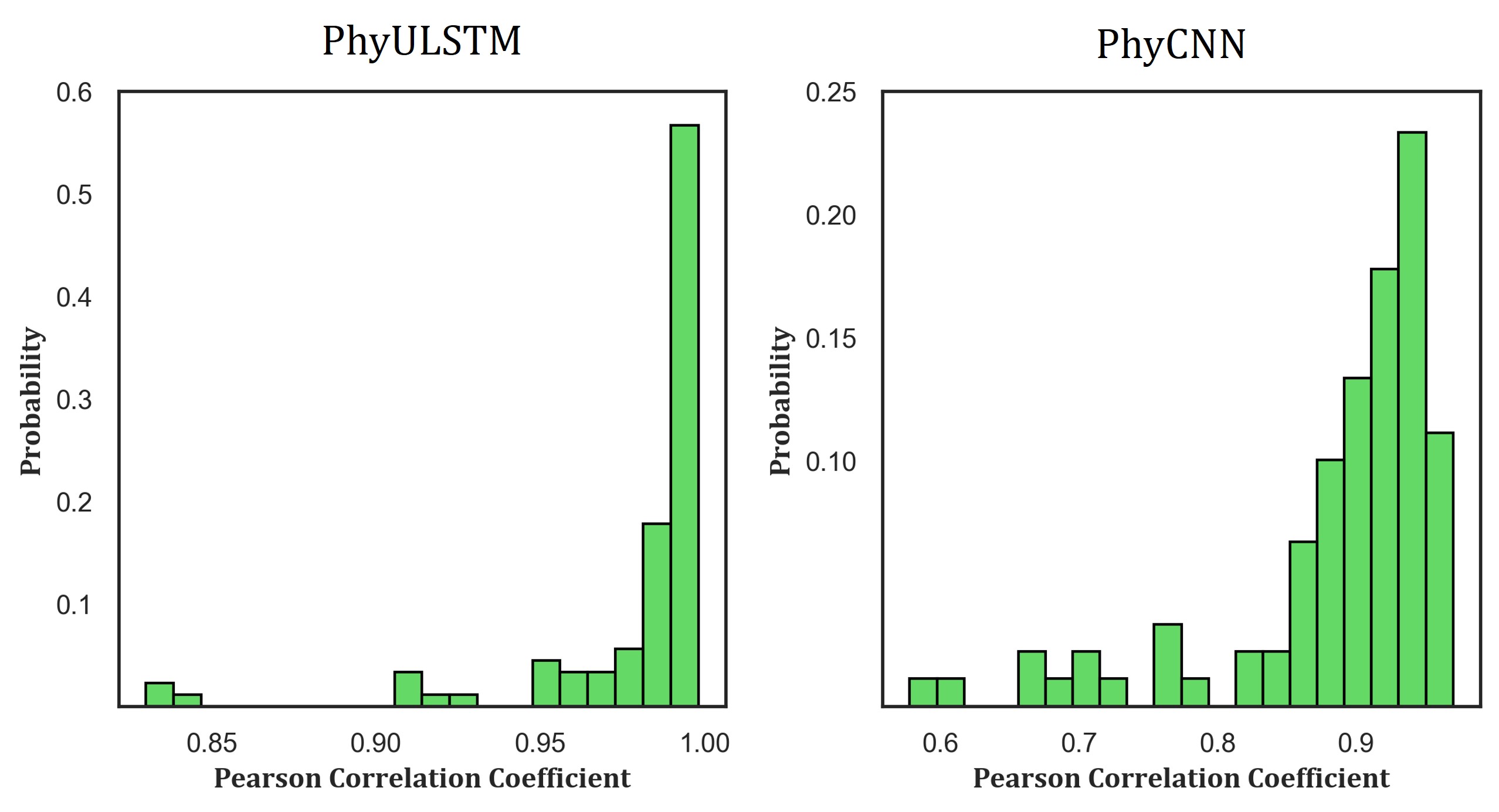Author: Denis Avetisyan
A new deep learning framework combines the strengths of U-Net and LSTM networks, informed by the laws of physics, to accurately model how structures behave during earthquakes.

This research introduces PhyULSTM, a physics-informed deep learning approach for data-driven seismic response prediction of nonlinear structural systems, demonstrating improved performance over existing surrogate models.
Accurate and efficient seismic response prediction remains a critical challenge in structural engineering, often limited by the computational cost of traditional physics-based methods. This paper introduces ‘A Physics-Informed U-net-LSTM Network for Data-Driven Seismic Response Modeling of Structures’, a novel deep learning framework-PhyULSTM-that integrates physical laws into a U-Net and LSTM architecture. Demonstrating superior accuracy and robustness, PhyULSTM effectively predicts the nonlinear seismic response of structures, outperforming conventional data-driven approaches. Could this hybrid methodology pave the way for real-time structural health monitoring and resilient infrastructure design?
Unveiling the Limits of Prediction: The Seismic Modeling Challenge
Predicting how structures will behave during earthquakes has long presented a significant computational challenge. Traditional methods, rooted in detailed physics-based modeling, often demand immense processing power, particularly when simulating the complex, nonlinear behavior of large structures subjected to strong ground motion. To make these calculations feasible, engineers frequently employ simplifying assumptions – such as linear elastic material properties or idealized geometric representations – that can compromise the accuracy of the predictions. While necessary for practical application, these simplifications introduce uncertainty, potentially underestimating the true seismic demands and impacting the reliability of safety assessments. The inherent trade-off between computational cost and model fidelity remains a central hurdle in achieving truly accurate and efficient seismic response prediction.
The ability to accurately forecast how structures will behave during earthquakes is paramount for both designing resilient buildings and evaluating the safety of existing infrastructure. However, current predictive methods frequently falter when confronted with the complex, nonlinear responses exhibited by buildings under strong ground motion. These nonlinearities – stemming from material yielding, geometric changes, and the loss of stiffness – introduce significant challenges for traditional computational models, which often rely on simplifying assumptions to remain tractable. Consequently, predictions can deviate substantially from actual performance, potentially leading to underestimation of damage or, critically, inaccurate safety assessments. Addressing this gap requires innovative approaches capable of capturing the full spectrum of nonlinear behavior without sacrificing computational efficiency, a pursuit that remains central to advancing earthquake engineering and mitigating seismic risk.
Data-driven seismic response prediction methods, leveraging the power of machine learning, offer a compelling alternative to traditional computationally intensive simulations. However, these techniques frequently struggle with physical consistency. While adept at identifying patterns within training data, they often fail to extrapolate reliably to earthquake scenarios outside of that dataset – events with different magnitudes, frequencies, or fault mechanisms. This limitation arises because many data-driven models prioritize predictive accuracy on existing data without explicitly enforcing the fundamental principles of structural mechanics. Consequently, predictions can exhibit unphysical behavior, such as predicting structural responses that violate static equilibrium or material limits, rendering them untrustworthy for real-world safety-critical applications. Bridging this gap requires incorporating physics-informed machine learning, where physical laws are embedded within the model’s architecture or training process, to ensure both speed and reliability when faced with previously unseen seismic events.

Forging a New Path: Introducing PhyULSTM
PhyULSTM represents a new deep learning framework designed to enhance seismic response prediction by leveraging the complementary strengths of U-Net and Long Short-Term Memory (LSTM) architectures. The U-Net component facilitates the capture of spatial features within seismic data, while the LSTM network processes the temporal dependencies crucial for understanding wave propagation. This hybrid approach allows PhyULSTM to effectively model the complex relationship between input seismic parameters and resulting ground motion. The combination is intended to improve prediction accuracy compared to models utilizing either architecture in isolation, particularly for scenarios requiring both spatial and temporal analysis of seismic events.
The PhyULSTM framework utilizes a ‘Tensor Differentiator’ to compute the time and spatial derivatives of state variables necessary for modeling dynamic seismic events. This differentiator implements the ‘Central Finite Difference’ method, a numerical technique approximating derivatives based on values at neighboring points. Specifically, for a state variable $u(x,t)$, the first-order time derivative is approximated as $\frac{\partial u}{\partial t} \approx \frac{u(x, t+\Delta t) – u(x, t-\Delta t)}{2\Delta t}$, and the first-order spatial derivative as $\frac{\partial u}{\partial x} \approx \frac{u(x+\Delta x, t) – u(x-\Delta x, t)}{2\Delta x}$. This allows the model to internally calculate required derivatives without relying on explicit analytical solutions, accommodating complex geological structures and wave propagation scenarios.
Physics-Informed Loss functions within the PhyULSTM framework augment the traditional loss calculations during training by incorporating terms that represent the residual of governing physical equations. Specifically, these loss functions minimize the error between the model’s predicted state variables and the solutions dictated by established physical laws, such as those governing wave propagation in seismic data. This is achieved by calculating the derivatives of the predicted variables and substituting them into the relevant physical equations; the resulting difference constitutes the physics-informed loss. By minimizing this loss alongside conventional data-driven loss terms, the model is constrained to produce solutions that not only fit the observed data but also inherently satisfy fundamental physical principles, improving both accuracy and generalization capability.

Proof of Concept: Validation and Performance
Initial validation of the PhyULSTM framework was conducted using a ‘Nonlinear Single-Degree-of-Freedom System’ to assess its capability in modeling complex dynamic responses. This system, characterized by nonlinear restoring forces, allowed for a focused evaluation of the framework’s ability to accurately capture behaviors beyond linear assumptions. The validation process involved comparing PhyULSTM’s predictions against known analytical solutions for the nonlinear system, demonstrating its proficiency in replicating intricate dynamic characteristics such as amplitude and frequency modulation, and confirming its suitability for subsequent application to more complex structural models.
The PhyULSTM framework underwent rigorous testing utilizing data from the San Bernardino Hotel Building, a six-story reinforced concrete structure. This building served as an ideal validation case due to the availability of comprehensive experimental data obtained during a series of controlled experiments. The dataset includes detailed measurements of structural response to dynamic loading, allowing for a direct comparison between PhyULSTM’s predictions and observed behavior. The building’s characteristics – including its material properties, geometric configuration, and foundation conditions – are well-documented, enabling a precise assessment of the framework’s ability to model real-world structural dynamics.
PhyULSTM demonstrated high accuracy in both numerical and experimental validations. Numerical simulations achieved a maximum correlation coefficient of 0.998 when compared to ground truth data. Experimental validation, conducted on a six-story reinforced concrete building, showed that 94% of predicted displacements exhibited a correlation coefficient greater than 0.9. These results indicate PhyULSTM consistently outperforms traditional methods in capturing structural dynamics and predicting displacement behavior.

Beyond Prediction: Expanding the Horizon and Impact
The newly developed PhyULSTM framework represents a significant advancement in physics-informed deep learning, demonstrably surpassing the capabilities of previous methods like PhyCNN. Utilizing a unique architecture, PhyULSTM achieves a remarkable 94% accuracy in predicting structural displacements, evidenced by a strong correlation coefficient exceeding 0.9. This performance stands in stark contrast to PhyCNN, which attains only 80% accuracy under the same conditions. The improved flexibility of PhyULSTM allows it to more effectively integrate physical laws into the learning process, resulting in more reliable and precise predictions of structural behavior and offering a powerful tool for applications demanding high fidelity simulations.
The advent of this physics-informed deep learning framework promises a significant leap forward in seismic risk assessment. Current methods often struggle with the inherent complexity of structural response to earthquakes, leading to inaccuracies in vulnerability predictions. However, by integrating physical laws directly into the learning process, this new approach allows for more nuanced and reliable simulations of how structures will behave under stress. This capability isn’t simply about improving existing predictive models; it facilitates a paradigm shift towards proactive risk management, enabling engineers to identify vulnerabilities with greater precision and design resilient infrastructure. Consequently, communities can better prepare for seismic events, minimizing potential damage and saving lives through more informed and effective mitigation strategies.
Ongoing development of the PhyULSTM framework prioritizes scalability to encompass increasingly complex structural systems, moving beyond simplified models to accurately represent real-world engineering challenges. This expansion includes investigations into handling non-linear material behaviors and intricate geometries, crucial for assessing the resilience of diverse infrastructure. Simultaneously, research is directed towards integrating robust uncertainty quantification methods, acknowledging the inherent variability in material properties, loading conditions, and model parameters. By explicitly accounting for these uncertainties, PhyULSTM aims to provide not just point predictions, but probabilistic forecasts, enabling more informed and reliable decision-making in critical applications such as seismic risk assessment and structural health monitoring, ultimately fostering designs that prioritize safety and sustainability.

The pursuit of accurate seismic response modeling, as demonstrated by PhyULSTM, isn’t merely about creating a predictive tool-it’s about systematically dismantling conventional limitations. The framework actively integrates known physical principles, effectively challenging the ‘black box’ nature often associated with deep learning. This mirrors a fundamental tenet of exploration: to truly understand a system, one must probe its boundaries. As John McCarthy observed, “Every worthwhile endeavor has an element of apparent madness.” PhyULSTM’s innovative approach-combining U-Net and LSTM with physics-informed training-embodies this ‘madness’, boldly pushing the limits of data-driven modeling for structural dynamics and ultimately offering a more robust and reliable prediction of nonlinear systems.
What Bugs Reveal
The PhyULSTM framework, while demonstrably effective, operates within the constraints of defined structural models. One wonders if the residual error – the variance not captured by the network – isn’t simply noise, but a signal of previously unconsidered dynamic behavior. Is the network, in its pursuit of accurate prediction, inadvertently filtering out genuinely novel responses-those that fall outside the assumptions baked into the training data? Perhaps the true value lies not in minimizing error, but in characterizing where the model fails, and what those failures suggest about the system’s hidden complexities.
Future iterations should not solely focus on architectural refinements. Instead, attention should be directed toward actively challenging the physics-informed constraints. Can the network be coaxed – or allowed – to explore parameter spaces that violate established structural assumptions? To treat the governing equations not as immutable laws, but as hypotheses to be tested? The goal isn’t simply to build a better predictor, but to use the network as a probe-a tool for reverse-engineering the underlying physics of structural response.
Ultimately, the success of this approach-and of physics-informed machine learning in general-will hinge on recognizing that the ‘bug’ isn’t always a flaw. Sometimes, it’s a glimpse of something genuinely new, a hint that the rules, as understood, are incomplete.
Original article: https://arxiv.org/pdf/2511.21276.pdf
Contact the author: https://www.linkedin.com/in/avetisyan/
See also:
- Super Animal Royale: All Mole Transportation Network Locations Guide
- The best Five Nights at Freddy’s 2 Easter egg solves a decade old mystery
- bbno$ speaks out after ‘retirement’ from music over internet negativity
- Gold Rate Forecast
- Brent Oil Forecast
- ‘M3GAN’ Spin-off ‘SOULM8TE’ Dropped From Release Calendar
- Zerowake GATES : BL RPG Tier List (November 2025)
- ‘Welcome To Derry’ Star Confirms If Marge’s Son, Richie, Is Named After Her Crush
- Avengers: Doomsday Trailer Leak Has Made Its Way Online
- Katanire’s Yae Miko Cosplay: Genshin Impact Masterpiece
2025-11-27 22:15